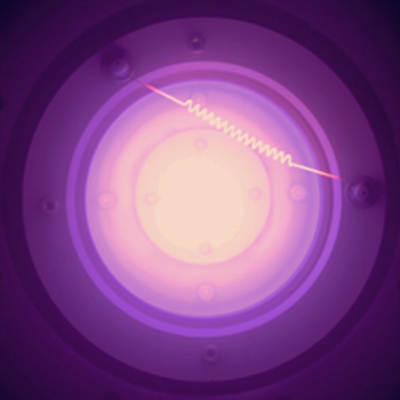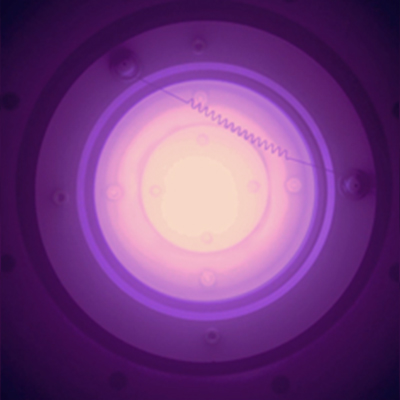Plasma Video Explanation
Did you see what happened on the homepage? Go there now and watch again.
The video shown there is the light turning on the Plasma. Here is the explanation.
What is a plasma, how do we create it, and what do we do with it?
Plasma: an electrically charged gas. Plasma is created by removing one or more electrons from a gas. We remove those electrons by causing collisions with atoms that knock an electron off the subject gas.
Creating a plasma – These images show the KRI RF2100ICP plasma source, chosen because it shows the plasma better than a gridded source.
Step 1:
To make ignition easier, we create extra electrons to accelerate into the atoms. The hot filament shown is so hot that electrons are flowing off of it!


Step 2:
We flow Argon gas into the discharge chamber and use oscillating electromagnetic waves to move the Ar gas and electrons around. The free electrons from the filament are much lighter than the Argon atoms and therefore move much faster. When a free electron strikes an electron on the Argon atom, it can knock it loose. The energy of the collision gives the Argon plasma its purple glow.
Step 3:
Now this process is self-sustaining, it no longer needs the extra electrons to maintain the plasma and the filament is turned off.

What do we do with a plasma?
The Argon plasma ions are moving at a specific speed. These ions flow out of the open end of the source and this ion speed is energy that is used to atomically clean a material prior to other coating steps (via bombardment – knocking atoms off a surface) or after coating steps to densify a film (hitting atoms hard enough to push them down and removing gaps in films layers). Ion energy can be used to help create semiconductors and lens coatings and spacecraft engines and neon signs. We make ion sources with ion beams at very specific energies, densities, and beam shapes for a large variety of applications.


